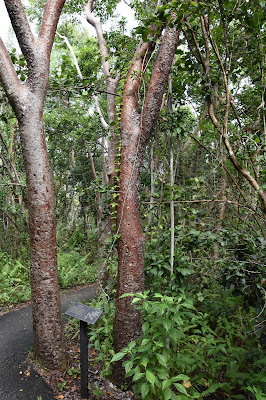The main entrance to the Everglades National Park is on its Eastern border towards the South end on Highway 9336. It is an easy drive from Homestead. The Ernest F. Coe Visitor Center provides maps and other information. There are ranger-led activities every day. We were in good time for that day's ranger-guided walk on the Anhinga Trail.
Anhinga Trail
The trail is freely accessible, but the ranger made it much more interesting than strolling around on our own. She was a retired university scientist so her knowledge was excellent and she was an experienced teacher. One of the younger members of the group was given the task of keeping count of the individual wild animals we saw along the way. The mechanical counter was kept very busy. As was Bill's camera.
Baby alligators are guarded by their mother for a while, because they are preyed upon by so many birds and other creatures. Including adult alligators.
An Anhinga drying its wings. Unlike ducks, their feathers are not water-repellent and get soggy while they are fishing.
Green Herons have a combination of shape, colour, pattern and gleaming eye that really grabs the attention.
Pineland Trail
This is a short loop walk – only 400 yards – by the road. It's advertised attractions are the remnant of Slash Pine forest and some special snails, but we got lucky.
Other Locations
There are plenty of places to stop and enjoy nature. We appreciated the numerous information boards.
A “Solution Hole”. Mild organic acid from decaying plants and rainwater very slowly dissolve limestone to form these holes. The level of water represents the ground water table over the whole area. So there's not much dry land under our feet.
We mentioned in a previous post how flat Florida is. Here's some more evidence. In a sense, this is a river because water flows very slowly through the grass to the sea.
In mountainous regions it is common to find a sign where the road goes over a pass to tell you how high you are. We noticed two such signs along the road to Flamingo. In both cases the “pass” was less than 10 feet above sea level!
Some Everglades flowers:
We had to leave some of the places of interest for another day. There are so many. The road ends at Flamingo, where there is a very large campground. It was almost empty, but was expected to be full in a couple of weeks. We selected a site near an ablution block. There was just one problem; no hot water. Only one block had hot showers, and that was by the tent sites. We were welcome to use them if we were happy to march all that way with our towels.
The block near us was a meeting place for Black Vultures. They inspected us appraisingly.

































No comments:
Post a Comment